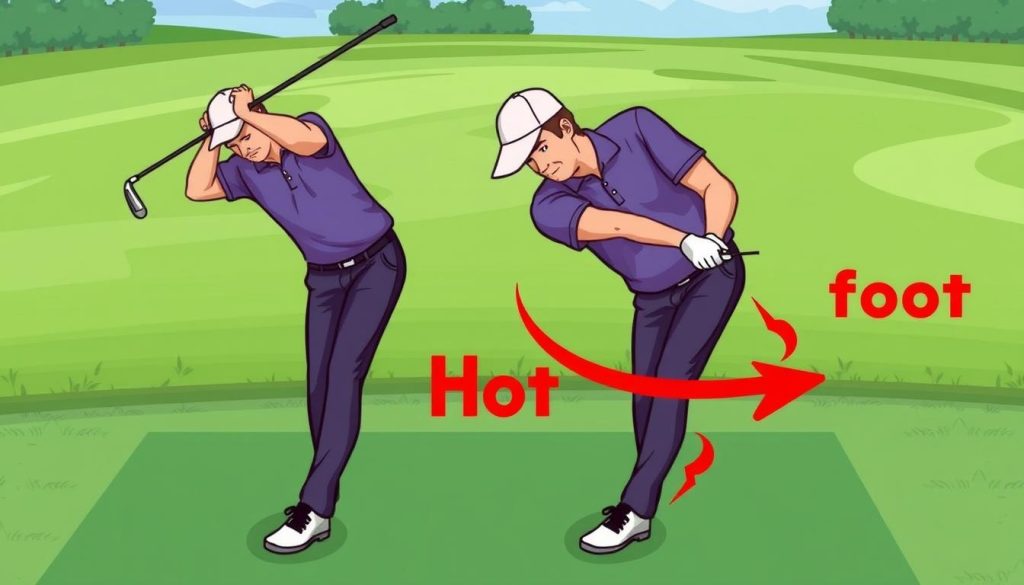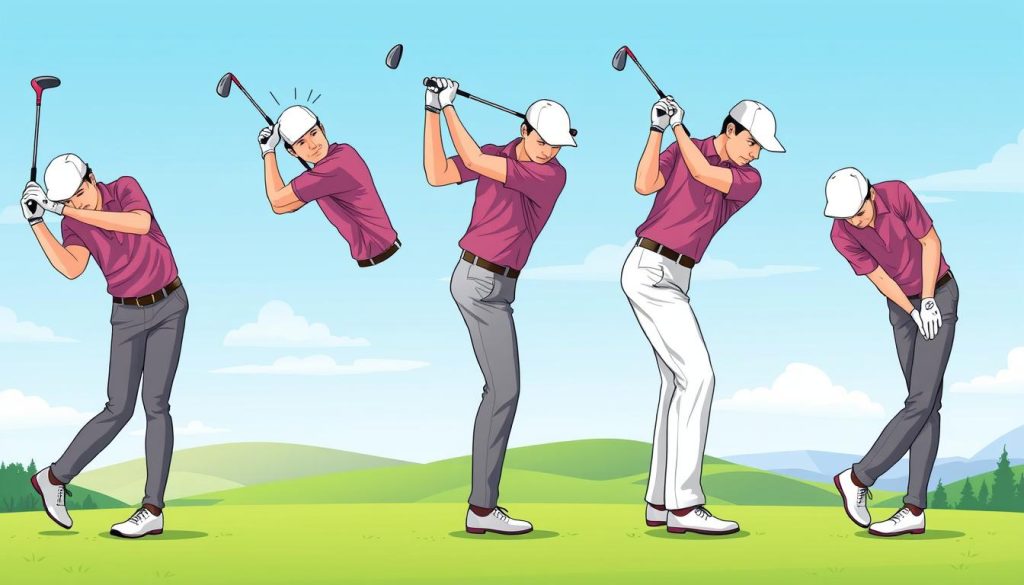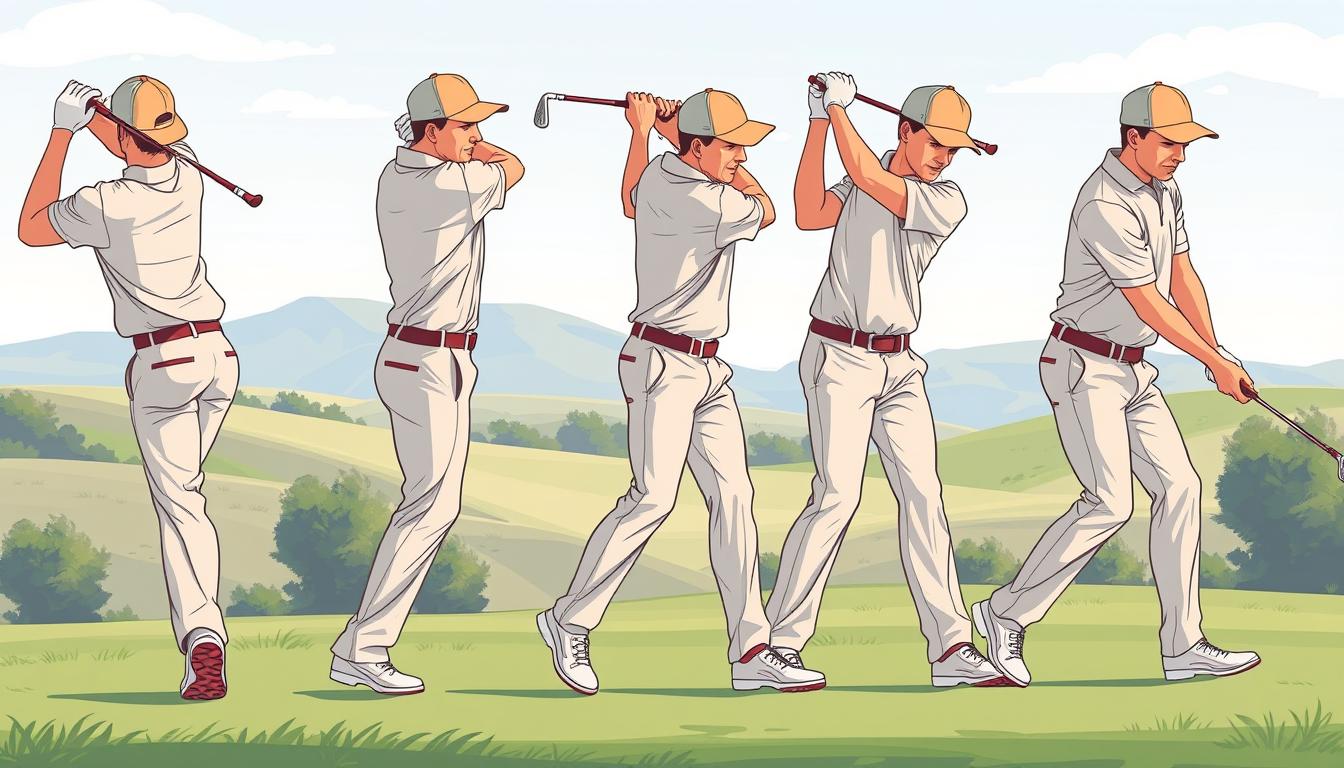Your golf swing mechanics are key to mastering the game. Knowing the right golf swing order and timing can boost your game. This guide covers the essential parts of a great golf swing sequence. It helps you improve your technique at every step.
Golf is a game that needs precision and skill. The grip and stance are the base of a strong swing. Stand with your feet parallel to the target line and shoulder-width apart for a solid stance.
As you move into the backswing, keep the wrist hinge right. Rotate your body smoothly. This is crucial.
Timing is everything in golf. Releasing your wrists correctly in the downswing is vital. The moment of impact is key, affecting the ball’s path and distance. A balanced swing ensures control, leading to accuracy and power.
Key Takeaways
- Master the grip and stance for a solid foundation
- Focus on smooth body rotation during the backswing
- Time the wrist release properly in the downswing
- Emphasize balance and control throughout the swing
- Practice consistently to perfect your golf swing sequence
- Consider working with a golf coach for personalized advice
Understanding the Fundamentals of Golf Swing Mechanics
Golf swing mechanics are key to playing well. Learning these basics can really boost your game. Let’s explore the essential parts of a good golf swing order. Proper stance and posture set the foundation for a controlled and powerful swing, followed by a smooth backswing and balanced downswing. Equally important are golf swing release techniques, which ensure a fluid transition and proper follow-through, maximizing accuracy and power. Mastering these elements takes practice but can significantly elevate your overall performance on the course.
The Role of Body Alignment
Body alignment is vital in golf. Keeping your spine straight and slightly bending at the waist is crucial. Your feet, hips, and shoulders should line up with your target.
This alignment helps you hit the ball more consistently and accurately.
Weight Distribution Basics
Weight distribution is important in your golf swing. At the start, your weight should be evenly split between both feet. As you swing, your weight shifts.
In the backswing, it moves to your back foot. In the downswing, it shifts to your front foot. This movement helps you hit the ball farther.
Core Movement Principles
Your core is the heart of your swing. Start with big muscle movements and then add smaller ones. This helps you swing smoothly and powerfully.
Remember, it’s more important to be consistent and controlled than to be very strong. Aim for a balanced finish to ensure proper follow-through.
| Swing Phase | Key Action | Focus Area |
|---|---|---|
| Address | Align body | Feet, hips, shoulders |
| Backswing | Shift weight | Back foot |
| Downswing | Transfer weight | Front foot |
| Impact | Core engagement | Torso rotation |
| Follow-through | Balance finish | Whole body |
By focusing on these basics, you’ll lay a strong foundation for your golf game. Remember, mastering your swing takes time and practice. Working with a golf instructor can help you learn faster and avoid common mistakes.
Perfect Setup Position and Address
Getting your golf stance, ball position, and posture right is key for a good swing. A balanced setup is the base for playing well. Let’s look at what makes a good address position.
Your feet should be shoulder-width apart for most shots. This width helps you stay stable and rotate properly. For drivers, make your stance a bit wider for a bigger swing. With wedges, stand closer together for better control.
Where you place the ball changes with each club. For drivers, put the ball off your front heel. With irons, it should be in the middle of your stance. For wedges, move it a bit back. These changes help you hit the ball better with each club.
Good posture is essential. Keep your back straight, knees a bit bent, and bend at the waist. Stand evenly on the balls of your feet. This stance helps you swing smoothly and powerfully.
Your grip is important for your swing. Try these common grips:
- Interlock: Right pinky between left index and middle finger
- Overlap: Right pinky rests on groove between left index and middle finger
- Ten-finger: All fingers on the club, no interlocking
A solid setup is the start of a great golf swing. Practice these basics to get better and play more consistently.
Mastering the Golf Swing Sequence Guide
A successful golf swing sequence is key to improving your game. Let’s break down each phase to help you perfect your technique.
The Takeaway Phase
The takeaway sets the tone for your entire swing. Use your big muscles to draw the club back along the target line. Keep your movements smooth and controlled.
Backswing Position
During the backswing, rotate your clubface and engage both large and small muscles. Aim to end with the clubhead over your left shoulder for right-handed golfers.
Transition Movement
The transition is crucial. It’s where your swing changes direction, initiated by your lower body. This movement sets up the power for your downswing.
Downswing Mechanics
In the downswing, throw your hands and club at the ball while maintaining wrist hinge. Engage your leg muscles to drive towards the target, shifting pressure to your front foot.
Impact Position
Your impact position varies based on the club you’re using. For fairway shots, the ball should be in the center of your stance. With drivers, position the ball slightly forward.
Follow-through Completion
Complete your swing with a full body rotation towards the target. Extend your arms fully, lower your right shoulder, and shift your weight to your left foot.
| Swing Phase | Key Action |
|---|---|
| Takeaway | Use big muscles, move along target line |
| Backswing | Rotate clubface, end over left shoulder |
| Downswing | Engage legs, shift weight forward |
| Impact | Varies by club, maintain wrist hinge |
| Follow-through | Full body rotation, extend arms |
Remember, perfecting your golf swing sequence takes practice. Focus on each phase individually before putting it all together for a fluid, powerful swing.
Power Generation Through Proper Hip Rotation
Mastering hip rotation is key to unleashing power in your golf swing. Let’s explore the mechanics of hip turn, lower body movement, and core engagement to improve your game.
Hip Turn Mechanics
A proper hip turn is essential for a powerful swing. Aim for a 65-degree rotation instead of 90 degrees. This controlled movement uses more muscle fibers, making your swing more powerful with less effort.
Keep your right knee slightly rotated inward to prevent too much hip turn. This helps maintain balance and control.

Lower Body Movement
Your lower body starts the downswing, acting as a main power source. Avoid lifting your left heel during the backswing to prevent too much hip turn. Focus on a stable base to keep balance and control throughout your swing.
Core Engagement Techniques
Engaging your core is key for power and precision. Properly loading your core muscles increases torque and consistency. Try these core engagement drills to enhance your swing:
- Standing rotations with a golf club
- Seated twists with medicine ball
- Plank rotations
Adding these hip rotation drills and core engagement techniques to your practice will boost your power and swing mechanics.
| Aspect | Optimal Technique | Common Mistake |
|---|---|---|
| Hip Rotation | 65-degree turn | 90-degree overturn |
| Lower Body Movement | Stable left heel | Lifting left heel |
| Core Engagement | Loaded core muscles | Loose core |
The Critical Role of Timing in Your Golf Swing
Golf swing timing is key to a great game. A well-timed swing means powerful, accurate shots. Let’s explore timing and how to improve your swing rhythm.
Your backswing is the start of a successful shot. A slow, controlled backswing keeps balance and improves timing. At the top, aim for a 90-degree angle between your forearm and the clubshaft. This stores energy for a strong downswing.
The transition from backswing to downswing is vital. All parts of your body should move smoothly together. Start your downswing by rotating your hips. This energy transfer helps your clubhead.
Keep your wrist hinge during the downswing for more power. As you hit the ball, make sure your clubface is square to the target. This ensures straight shots.
Swing Rhythm Exercises
Here are exercises to improve your timing:
- Practice with a metronome for a consistent tempo
- Use swing plane drills to find the right path
- Do weight transfer drills for better timing and balance
- Use an impact bag to perfect your timing at impact
A proper follow-through helps with consistent shots and shows swing flaws. Regular practice and a pro’s guidance can improve your timing and game.
| Swing Phase | Timing Focus | Key Action |
|---|---|---|
| Backswing | Slow and controlled | Create 90-degree wrist hinge |
| Transition | Coordinated movement | Initiate with hip rotation |
| Downswing | Maintain lag | Transfer energy efficiently |
| Impact | Square clubface | Release stored energy |
| Follow-through | Complete rotation | Assess swing technique |
Common Swing Sequence Mistakes to Avoid
Golf swing mistakes can ruin your game. It’s key to spot and fix these errors to get better. Let’s look at some common issues and how to solve them.
Early Release Issues
An early release happens when you release your wrists too soon. This takes away power and accuracy. To fix it, keep your wrists hinged until just before impact. Try drills that help you release later to feel this change.
Incorrect Weight Transfer
Proper weight transfer is crucial for a good golf swing. Many struggle with moving their weight right. This leads to weak shots and inconsistent contact. Practice moving your weight to your front foot through impact for better results.
Poor Tempo Problems
Swing tempo is often overlooked but is very important. A fast backswing or jerky transition can mess up your swing. To improve, count “one” on the backswing and “two” on the downswing. This simple rhythm can help your swing feel smoother.
- Avoid tensing your hands, which restricts rotation
- Don’t swing too hard – it leads to loss of control
- Watch out for an over-the-top swing path causing slices
- Maintain a 90-degree right elbow angle for power
Fixing these common golf swing mistakes takes time and practice. Focus on one area at a time. Don’t hesitate to get help from a professional instructor. With patience and dedication, you’ll see your swing improve and your game get better.
Advanced Swing Path Training Methods
Golfers looking to improve their game can use advanced swing path training. These methods help refine your swing plane, analyze your form, and create effective practice routines.
Swing Plane Drills
Getting the swing plane right is key for consistent golf shots. Here’s a drill to help:
- Place an alignment stick in the ground at a 45-degree angle
- Practice swinging your club along the stick’s path
- Focus on keeping this plane during your swing
Do this drill 100 times without a ball to get the feel right. Aim for a 70% success rate before hitting balls.
Video Analysis Techniques
Video analysis is great for spotting swing flaws. Set up a camera to record your swing from various angles:
- Face-on view to check your swing plane
- Down-the-line view to see your body rotation
- Overhead view to look at your swing path
Watch your footage and focus on your grip, stance, and swing sequence. Look for any form issues.
Practice Routines
Creating a structured practice routine is key to improving your swing:
| Drill | Repetitions | Focus |
|---|---|---|
| Swing Plane | 100 | Maintain correct path |
| Weight Transfer | 50 | 55% lead leg at setup, 70% at impact |
| Rhythm Training | 30 | Consistent backswing to impact ratio |
Using these advanced swing path training methods in your practice will improve your swing. Focus on quality and gradual improvement.
Maintaining Consistency in Your Golf Swing
Achieving golf swing consistency is key to improving your game. Practice techniques play a crucial role in developing a reliable swing. Let’s explore some effective methods to enhance your performance on the course.

To maintain a consistent golf swing, focus on repeating the same setup and sequence. Develop a pre-shot routine to ensure a steady address position and mental preparation. This habit helps build muscle memory, leading to more predictable results.
Regular practice is essential for golf swing consistency. Dedicate time to work on your swing mechanics, paying attention to posture, grip, and alignment. Studies show that professional golfers have swings lasting about one second, while amateurs take 1.5-3.0 seconds. Aim for a 3:1 tempo ratio, with the backswing taking three times longer than the downswing.
- Use training aids like the Click Stick for audible feedback on your backswing
- Employ the SwingFix AI app to analyze and improve your swing
- Practice with the StraightAway aid to perfect your takeaway motion
Proper weight transfer during the backswing is crucial for generating power. Maintain the same posture throughout your swing to avoid thin or fat shots. Remember, body rotation is more important than excessive arm pushing or wrist movement for correct hand and club placement.
| Aspect | Professional Golfers | Amateur Golfers |
|---|---|---|
| Swing Duration | 1 second | 1.5-3.0 seconds |
| Swing Sequence | Highly consistent | Often fluctuates |
| Backswing Sequence | Wrists, arms, torso, hips | Variable |
By implementing these practice techniques and focusing on golf swing consistency, you’ll see improvements in your game. Remember, patience and persistence are key to mastering a reliable golf swing.
Conclusion
Improving your golf swing is a journey. It involves every part of your swing, from start to finish. Understanding the basics and practicing regularly is key.
Your swing begins with how you stand and where your weight is. As you move through the swing, use your big muscles and stay balanced. The downswing and impact are where you generate power, thanks to hip rotation and weight transfer.
Try not to make common mistakes like releasing too early or having a bad tempo. Use tools like video analysis and swing drills to get better. By focusing on each part of your swing, you’ll see big improvements in your game.
Remember, every golfer’s swing is different. Focus on making your swing the best it can be, not someone else’s. With hard work and the right approach, you’ll have a consistent, powerful swing that will take your game to the next level.
FAQ
What are the main components of a proper golf swing sequence?
How important is body alignment in the golf swing?
What is the correct weight distribution during a golf swing?
How can I improve my golf swing timing?
What role does hip rotation play in the golf swing?
What are some common golf swing mistakes to avoid?
How can I practice my golf swing at home?
What is the importance of the “lag” in a golf swing?
How can I improve my golf swing consistency?
What is the proper golf grip, and why is it important?
Source Links
- https://www.completesports.com/golf-swing-sequence-mastery-a-step-by-step-instructional-guide/?srsltid=AfmBOorE91NdrG91JjoBdbASOLc45-QHAu4vV5XTcocVBfR7aU_lKzRT
- https://www.performforgolf.com/blog/how-to-swing-a-golf-club-the-golf-swing-sequence-slow-motion-golf-swing-video
- https://skillest.com/blog/a-comprehensive-guide-to-mastering-the-golf-swing/
- https://hackmotion.com/golf-swing-basics/
- https://swingfit.net/golf-swing-mechanics/
- https://golf.com/instruction/perfect-golf-swing-balanced-setup/
- https://hackmotion.com/golf-swing-positions/
- https://lilyfieldphysio.com.au/blog/uncategorized/mastering-golf-swing-step-by-step-guide/
- https://tracergolf.ca/blog/unlocking-the-power-of-your-swing-mastering-the-role-of-legs-in-golf/
- https://konnectgolf.com/how-to-swing-a-golf-club/
- https://hackmotion.com/body-rotation-in-golf-swing/
- https://rotaryswing.com/c4/112298-fix-hip-overturning-in-your-backswing
- https://nationalgcla.com/the-basics-of-the-golf-swing/
- https://www.marygrovemustangs.com/perfecting-your-swing-advanced-techniques-for-serious-golfers.html
- https://hackmotion.com/common-golf-swing-mistakes/
- https://www.rvcc.com/blog/mastering-your-golf-swing
- https://www.bal-on.golf/en_US/blog-articles/trainwithbalon.html
- https://www.carttek.com/blogs/golf-equipment-blog/tips-for-consistency-off-the-tee?srsltid=AfmBOooePweRWqYOPw-gqTcH0MFyzZdNwqTT6JfX9Zt6ENw8M8YtixEi
- https://www.performancegolf.com/blog/golf-backswing-the-key-to-unlocking-more-golf-swing-consistency?srsltid=AfmBOorfH9XIvsHvokcJRxyuMqOM__1qtEZ4pMvhKhOcbmlWcOIgWrHs
- https://danfordgolfinstruction.com/perfecting-your-golf-backswing-a-comprehensive-breakdown/
- http://golfshane.blogspot.com/2012/03/swing-sequencing.html
- https://theleftrough.com/golf-swing-sequence/


